#And then in Depression when Pitch wanders around the streets of a city in 1930
Text
What I say: I’m fine
What I mean: In Dreamworks’ 2012 movie, Rise of the Guardians, it is hinted that the spirits in the world disappeared. No one knows why or what exactly is happening. And it is why several spirits power dramatically fell, like Pitch Black. Jack Frost wandered the world alone because of it. All the Pooka’s except for Bunny are gone. Anyone who aren’t tied to folklore or holidays disappeared. However, it is only mentioned in the online comics and art book. It is such a interesting and dark storyline, the disappearance of hundreds, maybe thousands, of people. And it not talked about in the movie at all.
#I can’t stop thinking about this#In rufftoon’s comics (which are non-official but canon in my heart) it’s implied pretty strongly that it’s colonization that did it#like in Old Hills when Jack pleads for answers when old hills goes silent and then turns around to see pioneers#And then in Depression when Pitch wanders around the streets of a city in 1930#in the art book it’s just… mentioned once and then never again#What happened to Bunny’s people? They disappeared but was it the spirit purge or something#I’m obsessed with this#rotg#rise of the guardians#jack frost#pitch black#e. aster bunnymund#sanderson mansnoozie#toothiana#nicholas st. north
1K notes
·
View notes
Text
Looking Around: Horizontal Space
If there is one truth about the second half of the 20th Century it is that, by all accounts, we started moving out rather than up; horizontal rather than vertical. Not only through the process of suburbanization, the building of massive highways, and the rapid capital flight from cities, but also in how we designed everything from our homes to our workplaces.
It could be said that, since the development of major highways, America has flattened -- much in the same way that the invention of both the elevator and air conditioning brought skyscrapers to every major city in the first half of the 20th century.
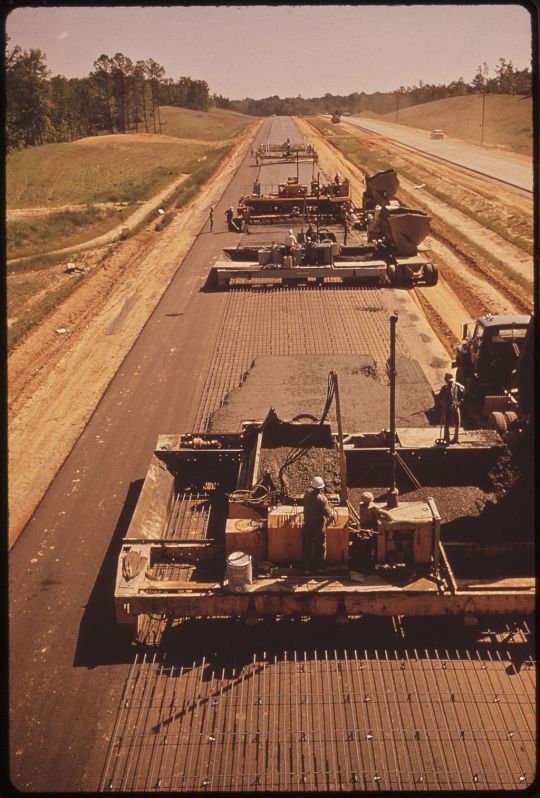
I-55 Under Construction, 1972. Public Domain.
In his 1984 book Discovering the Vernacular Landscape, John Brinckerhoff Jackson observes this transition:
“Who has not noticed...that in almost every American town the upper stories of the buildings flanking Main Street are being deserted?...Despite all the activity on the street floor, the second and third and fourth floors of the older brick buildings are no longer in demand. Not many years ago, they accomodated the offices of lawyers and dentists and doctors; dance studios and certified public accountants. Now the gold lettering has vanished from the windows, and even the street door leading to the stairs is blocked. Sooner or later, the buildings themselves will be torn down, to be replaced by one-story buildings or parking lots.” (68)
Jackson attributes this decline in vertical spaces to technological changes. Sprawling manufacturing plants with mile long assembly lines make more sense logistically than having workflow between stories. “An efficiently planned office,” he notes “is now seen as a system of information flow, most flexible, most effective when horizontal.” Even new skyscrapers are less like the ones from the recent past, described as “... a stack of large, uninterrupted horizontal spaces: vastly improved construction methods have made this spaciousness possible.” (69)
The technology of the car has created for us a new way of perceiving the environment around us. Jackson cites “increased mobility, and even more, an experience of uninterrupted speed...bring with them a sharpened awareness of horizontal space.” (70) Vertical space can’t be seen as easily from the car, the de facto way of getting around in America.
Residential Horizontalization
This transformation began with the Federal Housing Act of 1934, which established the Federal Housing Administration. The FHA originally provided home loans to qualifying (read: white) families during the Great Depression, as part of the New Deal, in an attempt to stabilize the mortgage market.
The FHA came to the forefront after WWII, when the Housing Act of 1949 began to systematically dismantle cities while simultaneously setting the guidelines of suburban sprawl. The Housing Act of 1949 worked in three parts:
1.) Federal financing for slum clearance (often coupled with highway building)
2.) Promised 800,000 units of public housing (the act actually destroyed more units of housing than it built)
3.) Increased financing for rural home loans and gave the FHA more authority to issue mortgages.
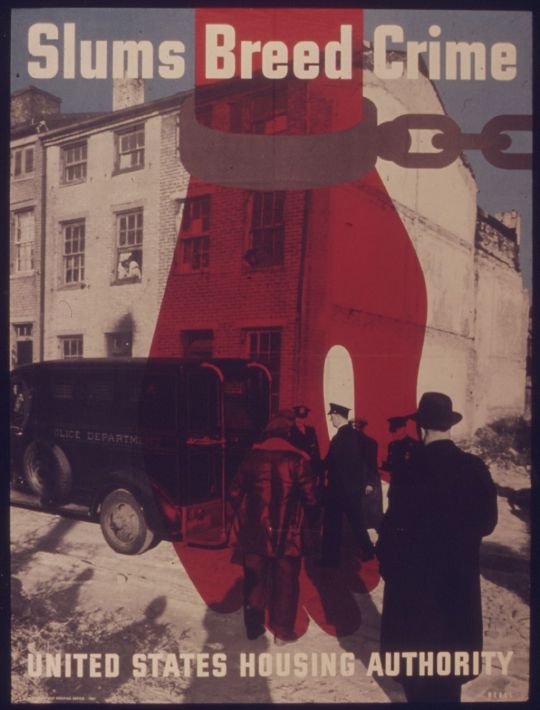
Poster from the 1940s.
This act had a devastating effect on cities. Not only did slum clearance destroy entire neighborhoods (often drawn along racial lines) and frequently replace them with highways (out to the suburbs!!), the process of Redlining (outlining areas deemed “high risk” and not worth issuing mortgages in, often in the inner city, almost always racially based) and the high preference for FHA-planned suburban communities over urban areas all but guaranteed a fully subsidized white flight from the cities.
What little public housing was built quickly fell into decline, as maintenance costs were tied to tenant rents - this, coupled with resistance to forced integration after Brown v Board of Education (1954) from whites led to their rapid depopulation of public housing. As a result, the remaining tenants could not offset the costs of empty units. This, coupled with a high youth density (unsupervised youths were often the cause of many maintenance problems - even benign ones, like breaking the elevators playing games of ‘elevator tag’), meant that existing public housing was quickly deteriorating. It was this combination of socioeconomic circumstances that led to the decline, and ultimately, the failure of the infamous Pruitt-Igoe housing complex in St. Louis, Missouri.
[For those of you who are interested in the policies and history of public housing, I recommend the books Public Housing Myths, and In Defense of Housing.]
The FHA and Suburb Planning
The FHA’s guidelines for issuing mortgages after the 1949 Housing Act centered around wide lots with driveways on streets organized to deter traffic, which had become a huge problem now that everyone had a car.
These wandering neighborhoods were often attached to arterial roads, but built with few entrances to these busy thoroughfares. Zoning was a huge part of why the curvilinear streets and island-like neighborhoods developed: the FHA was more likely to sponsor home loans to those looking to purchase a home in single-family residential zoned areas as part of its goal to protect lots from “adjacent non-conforming uses.”

However, it wasn’t always this way. In the earlier post-war suburbs, the FHA suggested subdivisions that were close to school, churches, the occasional commercial unit, and parks. What changed this was the 1956 Federal-Aid Highway Act, better known as the National Interstate and Defense Highways Act, which subsidized the construction of over a million miles of local and interstate highways. After these roads expanded exponentially, planning for less traffic meant sprawling deep into the countryside and the beginning of entirely new horizontal landscapes.
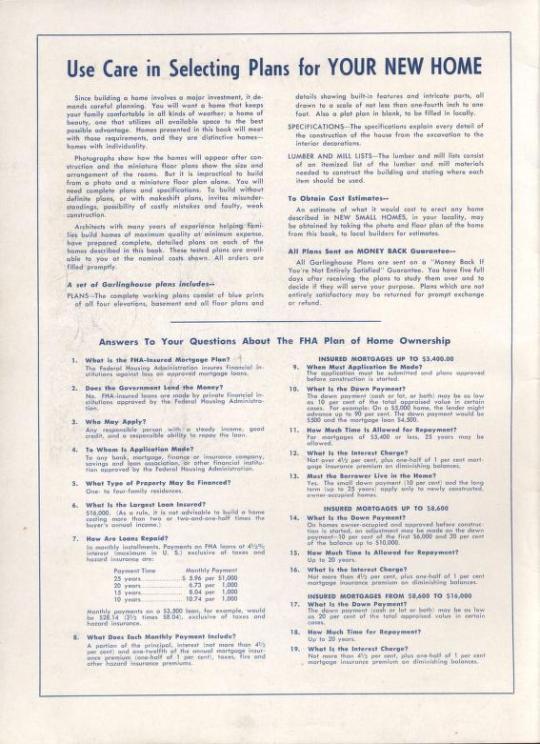
Garlinghouse Home Catalog insert from c. 1950
These policies imitated themselves in the architecture of common houses. The little post-war (white) working and middle-class Minimal Traditional house extended itself into the Ranch and Split-Level forms as lots grew larger and neighborhoods less dense. It was at this point that attached garages became ubiquitous, as car use had become increasingly necessary, cushioned by the increased lot size of the late 50s and beyond.
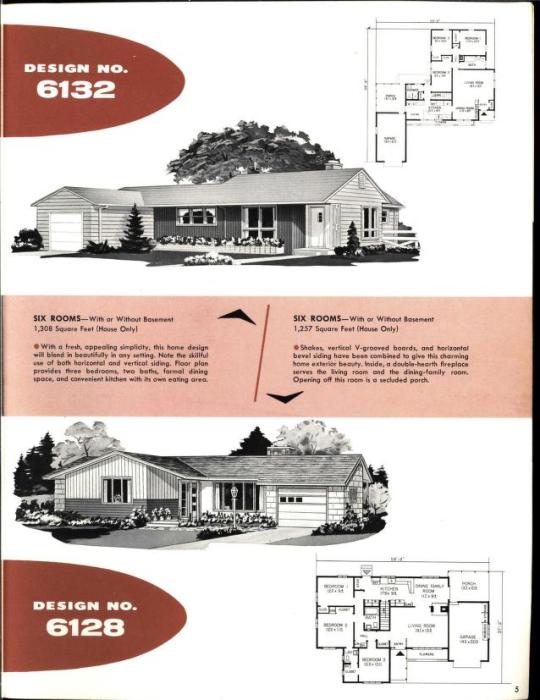
Catalog from 1958. Via Archive.org
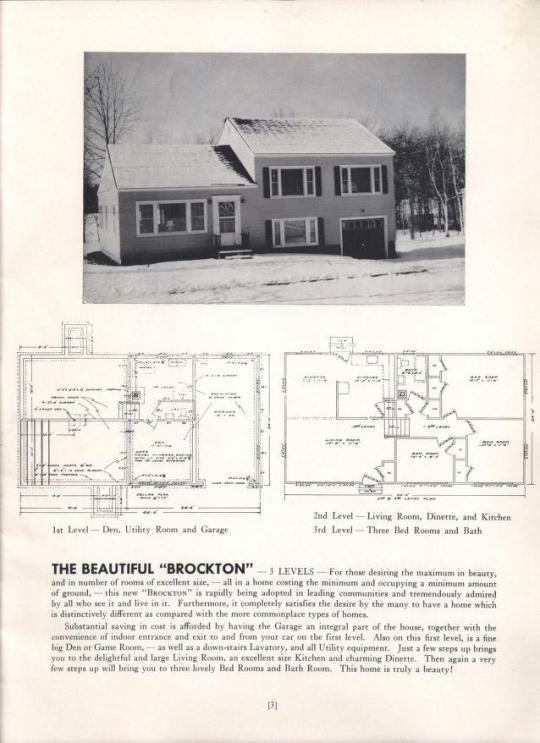
Northern Homes Catalog, c. Mid 60s. Public Domain.
For those who are curious, the origin of the McMansion lies in the Styled Ranches first popular in the 1930s in Hollywood and in more wealthier areas in the 1950s-1970s - these houses began the process of taking a basic built form (a Ranch) and applying various cladding materials and stylistic details to make it seem more elegant. For one-story McMansions, these houses are their predecessors.
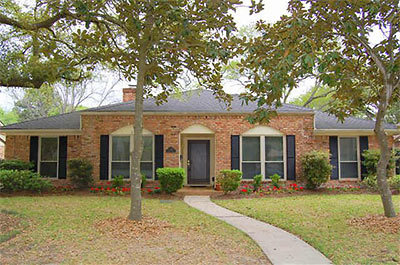
Styled Ranch (note the pitch of the roof) from the 1970s
The Split-Level ensured that two-story homes became hot commodities amongst middle class homeowners. By the early 1980s, (after the end of the Energy Crisis) homeowners rejected the low ceiling height of the ranches and split-levels, and, coupled with less expensive building materials and riskier mortgages, the McMansion had arrived. Their massiveness of scale was, perhaps, the only verticalization that occurred during this time.
Commercial Horizontalization
The depletion of urban density was not just a matter of people moving to little boxes on winding streets. Business moved as well. Factories, once located in dense urban settings, moved to the suburbs, where massive horizontal plants were created to streamline the work process. After all, the assembly line works horizontally.
If you’ve ever traveled outside of Chicago, you pass through the exurb of Naperville. While also being a verifiable McMansion Hell (perhaps no group of people own more McMansions than the managerial class), the I-88 corridor from Naperville to Aurora offers one of the most spectacular arrays of office parks in existence. Uncommonly more than five floors and rarely more than ten, these monoliths languidly straddle the flat prairie landscape, neatly bundled up by ribbons of highway.

Helmut Jahn’s interesting “N” Building off of I-88, Naperville, Illinois.
After WWII, corporations began a new way of organizing their businesses in order to adapt to new means of national and later international expansion. The new system was called “managerial capitalism” described by Louise A. Mozingo as “a transparent, rationalized administrative hierarchy... Rather than conferring positions based on ownership or nepotism, corporations awarded management authority to a meritocracy of salaried, professional managers.” (3)
The bosses and managers needed a new space along the same highway as the new factory (perhaps deliberately away from the workers themselves) and more amenable to expansion and technological development. It was for them that the modern office park was born.
It wasn’t just the office park - the highway also brought upon the world one of the most ubiquitous forms of building: the strip mall.
But how did this sudden transformation come about? In her book about corporate campuses, Pastoral Capitalism, Mozingo details exactly how the entire commercial world was scattered across the formal countryside:
“At the city’s edge, an effective alliance of well-financed real estate investors, large property owners, local governments, federal loan guarantors, and utopian planners opened property for speedy development. Building along federal- and state-funded road systems that brought these large tracts of land into the economy of metropolitan regions, this alliance conceived of low-density, auto-accessed landscapes of highly specified uses with plenty of parking, and wrote these forms into stringent zoning and building regulations.” (8)
The car-oriented technocracy of mid-century urban planning, emerging global capitalism, and government policies, completely terraformed the American landscape and made it, well, a landscape - horizontal in shape and in scope. Perhaps the most ironic aspect of these new developments is the appropriation of what they replaced. The banal, pastoral names of greenfield housing developments, malls, and strip malls, is but a memory of the eradicated landscape: Rolling Acres, Greenmeadow Heights, Slate Hills at Elysian Farms.
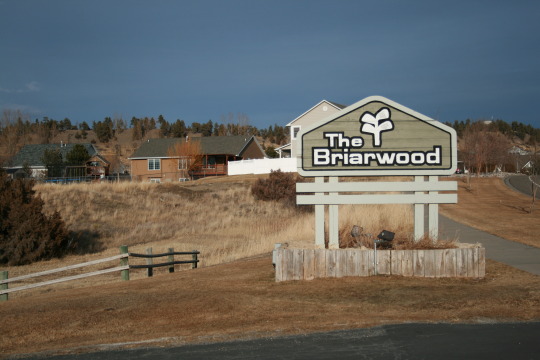
Photo by Sara Goth (CC BY-SA 3.0)
Re-Verticalization
In the cities, one by one, the lights of the old upper stories began to flicker out, entire avenues permanently for lease. The popularity of so-called “ruin porn” attests to the kind of nostalgic longing these old spaces engender in people young and old.
But curiously enough, the edge is becoming the center once more. Old derelict factories become spacious lofts, skyscrapers repopulate, uses become mixed, the lights begin again to flicker in the upper stories. For those with the financial mobility, the city is becoming vertical once more. As for the rest of us?
There is an ongoing and heady discussion about the repopulation of the cities. This essay is not the place for this discussion. As the infrastructure of the suburbs begins to wither and fray; as the malls close and the For Lease signs begin to shift from the city block to the office park, it is an interesting time to witness the shift of the American landscape back into some semblance of verticality.
The 20th Century saw the simultaneous birth of skyscrapers in the first half, and the mass flattening of the landscape in the second half. This massive transformation occurred at such a blistering pace, it became the new normal within twenty years, the flattening process seen only in hindsight. We’re running out of folks who remember the world before the hegemony of the car.

Abandoned Packard Auto Plant in Detroit. Photo by John Duce (CC BY-SA 3.0)
A few years ago, I woke up one day and read that the malls were dying. This news was shocking to me, despite the fact that I hadn’t been to a mall myself in years. Their sudden appearance and proliferation in the late 50s must have been seen as an equally surprising shock.
The purpose of Looking Around is to encourage people to take a critical look at the world they live in -- to appreciate its nuances, and take note of its changes. For those of us who pass by life at 45-80 miles per hour (often not by choice but rather necessity), it’s easy for these changes to blur into the fabric of endlessly horizontal scenery. For those of us in the cities, the news of the vacating office park surprises us, because we tend to believe that the edges - the burbs - are forever. Without taking a second to notice the day-to-day changes, one day we’ll wake up, flip on the news, and the whole world will suddenly be vertical again.
If you like this post, and want to see more like it, consider supporting me on Patreon! Also JUST A HEADS UP - I’ve started posting a GOOD HOUSE built since 1980 from the area where I picked this week’s McMansion as bonus content on Patreon!
Not into small donations and sick bonus content? Check out the McMansion Hell Store ! 100% of the proceeds from the McMansion Hell store will go to help victims of Hurricanes Harvey & Irma
Copyright Disclaimer: All photographs are used in this post under fair use for the purposes of education, satire, and parody, consistent with 17 USC §107. Manipulated photos are considered derivative work and are Copyright © 2017 McMansion Hell. Please email [email protected] before using these images on another site. (am v chill about this)
#architecture#urbanism#history#vernacular architecture#architectural history#suburbs#suburbia#20th century#american history
1K notes
·
View notes